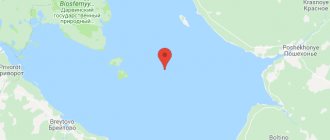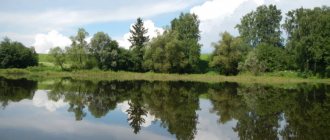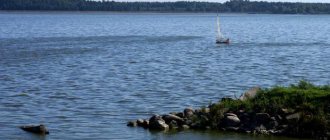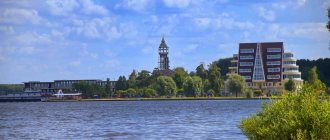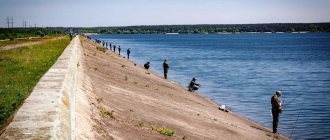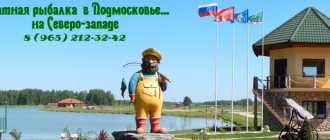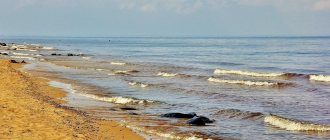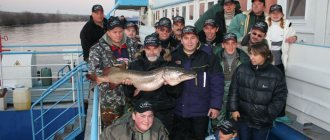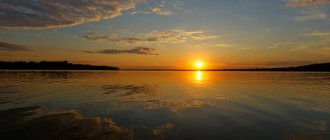A visit to this picturesque reservoir will be remembered for its generous catches of pike and bream. These places are home to a large number of these fish species. The Ivankovo Reservoir is also called the Moscow Sea, it is located at the source of the Volga and has the following characteristics:
- up to 2.5 kilometers wide;
- about 120 kilometers long.
A nine-kilometer dam, the height of which reaches 14 meters, holds the reservoir. Previously, the population manually filled the dam with large stones to strengthen the structure.
How to get to the Ivankovskoye Reservoir?
In 1937, the Ivankovo Dam blocked the Volga River. As a result, a large reservoir called the Moscow Sea appeared. The following were wiped off the face of the earth by water:
- More than 32,000 hectares of land.
- 106 villages that were in the flood zone.
- County town of Korcheva.
- Wide fields.
- Swampy places.
With a small water mark, the area of the entire surface can reach 47, 39 and 10 square meters. m. The decrease in water level can be less than 8 meters, then the reduction in territory can be more than 4 times. There are several options for arriving at the fishing spot on the Ivankovskoye Reservoir:
- By electric train. Tourists need to travel on it from Savelovsky station to Bolshaya Volga station. In case of landing from the Leningradsky railway station, it will arrive at the State District Power Plant station.
- By personal transport. You need to drive up to 131 kilometers along the Leningradskoe Highway, then turn right to the recreation centers.
- By train. The departure of this transport starts from the Moscow-Tver station to Redkino. After this, you should take a bus to the Turbaza stop.
What kind of fish can you catch?
The reservoir contains a large number of islands with beautiful scenery, where fishermen can take refuge from strong waves and wind in bad weather. Fishing bases are often located in such places; these establishments provide various types of services to their guests. The species of fish living in the Ivankovo Reservoir are as follows:
- undergrowth;
- roach;
- pike;
- zander.
This reservoir is most populated by bream. This fish has proliferated so much, as a result of which it has become very crushed and its condition corresponds to that of a trash fish. This is the result of the privatization and ruin of fish processing enterprises in the 90s:
- Konakovsky.
- Melkovsky.
- Tverskoy.
Since fishing cooperatives could not sell their catches, and the basis of the enterprises was bream over 3 kg, therefore fishing on an industrial scale ceased.
Perch is the second most commonly caught fish in the reservoir. Their weight in this area reaches 200 grams. When fishing in flooded ravines and river beds, you can catch fish weighing over 500 grams, and in some autumn and winter periods the weight of the catch reaches over 1.5 kilograms.
In third place in terms of the number of habitats in these places are:
- roach;
- silver bream;
- bleak;
- ruff.
Recently, the number of ruffes has become significantly smaller, because in the hot summer the water temperature can warm up by more than 25 degrees even at the greatest depths, and for them this is not a suitable temperature for life.
The presented reservoir is also home to very popular species of pike, pike-perch, large-sized catfish and asp, and tench in the bays; carp, white and red crucian carp, as well as a large number of sabrefish, growing in length over 30 centimeters, also live in this area. There is ide, but you can catch it in very rare cases. There are crayfish.
To catch predatory species, fishermen use spinning rods with fish-shaped bait or lures.
| Fishing | About fishing in the Konakovo region | How can I get to | Where to stay | Useful contacts |
Fishing and sports base "Big Volga" and fishing on the Moscow Sea
Fishing and sports base "Big Volga" is located on the shore of the Moscow Sea bay, 125 km from Moscow. You can get to it from the Bolshaya Volga railway station through the village of Ivankovo and, having reached the Moscow Canal, you should cross to the other side. In the summer, there is transportation for pedestrians; in the winter, a pontoon bridge is installed. Having crossed the canal, you need to walk a little along the bank to the left, focusing on the house with the flagpole. It houses a base with 140 boats and 28 overnight accommodations. The bay on which it is located is of interest to anglers in summer and winter. It is heavily snarled, especially on its left side, which goes inland towards the forest. Here at the bottom of the bay there are many stumps left from the cleared forest. In the summer they are hidden by water, and at the end of winter the stumps with caps of ice protrude out. A flooded, winding channel runs through the middle of the bay. The proximity of the base to the railway station (about 20 minutes walk), good communications and the presence of interesting places for fishing attract many anglers here. Vehicles heading to the base are transported across the canal by ferry, which operates all year round. It is located on the 117th km of the highway connecting the capital through the city of Dmitrov with the village of Ivankovo and the city of Dubna. Thirty years ago, the Volga channel was blocked by a dam, and on March 23, 1937, the filling of the Ivankovo Reservoir began, which was then called the Moscow Sea. The Moscow Sea is located in the Kalinin region. Only a small section of it, adjacent to the Bolshaya Volga pier, the monument to V.I. Lenin, the dam and the dam, is located in the Moscow region. Created today, this freshwater sea is the largest body of water near the capital. Good access routes, a relatively short distance from Moscow, and many cozy places for fishing have made the Moscow Sea one of the most favorite bodies of water visited by sports fishermen. The Moscow Sea, naturally, has its own characteristics that determine fishing conditions. The seashores are sloping, low-lying, with a predominance of pebble, clay, silt and peaty soils, covered with forest, mainly coniferous. The vegetation is represented by mixed pine and spruce forest, meadow and marsh grasses, sphagnum mosses. Due to the shallow waters of the coastal zone, fishing off the seashore in summer is unattractive. Only in places, where the flooded bed of the Volga approaches the shore or near the locations of dams, piers, as well as on the slopes of flooded ravines and hollows. Here you can find a convenient place for shore fishing with float or bottom fishing rods. Therefore, in the summer, as a rule, fishing from boats is more successful. In winter, the sea becomes accessible everywhere. There is no corner on it where fishermen do not penetrate. According to its shape, the reservoir is divided into three reaches: Volzhsky - from the city of Kalinin to the city of Konakovo, Shoshinsky - formed by the overflow of the dammed Shosha River (the right tributary of the Volga), from the city of Turginovo to the mouth of this river, Ivankovsky - from the city of Konakovo to the Ivankovo dam. The Volzhsky reach is narrow, more flowing, but it is negatively affected by the influence of wastewater from the city of Kalinin. The Shoshinsky reach is shallow, wide and has little flow. In winter, it is susceptible to fish kills, and in summer there is a significant “water bloom.” These phenomena are explained by a lack of oxygen in the water and, naturally, have a bad effect on the fish’s bite. The Ivankovsky reach has a flow rate almost three times greater than Shoshinsky, and in winter it increases five times compared to summer conditions. Of course, these features of the reach also have a positive effect on fishing. It has large and small bays, and a number of small streams and rivulets flow into it. There are many islands on the stretch, behind which you can always find a calm from the wind and waves. In the bays and between the islands there are flooded hollows, ditches, stream beds, bushes, and unuprooted stumps from cleared forest. Reeds, reeds and cattails grow near the islands and shores. These places are free for fish and most interesting for anglers. When choosing a place for fishing, you must remember that the Moscow Sea is a regulating reservoir, and the water level, especially in winter, changes. And changes in level and depth inevitably cause significant movements of fish. Therefore, on the Moscow Sea, a fisherman must change fishing locations in accordance with the specific situation. It should be remembered that in spring fish are more likely to stay in shallow water areas well warmed by the sun. In the bays of the reach, where aquatic vegetation first appears, serving as food and shelter for young fish, spawning of most fish occurs. In the hot summer and during the “water bloom”, there is a lack of oxygen in shallow waters, the water acquires a putrid odor and an unpleasant taste. Therefore, at this time the fish leaves shallow places and goes to deeper areas of the reach with better oxygen conditions or moves to areas with greater flow. In winter, as the water in the Moscow Sea recedes, the fish leave the irrigation areas and approach the beds of flooded rivers and streams. Particularly severe freezes occur when the water declines in the Shoshinsky Reach. This happens because in the upper part of the reach there are flooded meadow lakes where algae grow, which completely absorb the oxygen of the water when they die. Most of these lakes are connected by ditches to the bed of the flooded Shoshi River. When the level drops sharply, a huge amount of oxygen-deprived water enters the Shoshi riverbed and destroys all living things. In such winters, there is a large accumulation of fish in the Dobitse River, which flows into the Shosha River below the highway bridge, near the village of Bezborodovo. In recent years, Shoshinsky Reach has been declared an experimental reserve, and all fishing in it has been stopped. And for those who find themselves in winter on the Shosha River below the highway bridge, and especially below the mouth of the Dobitsa River, we recommend that you remember that the thickness of the ice here often does not exceed 1 cm. Considering that in Dobitsa itself and other places at the same time the ice is thicker than half a meter , this danger is sudden. This is explained by the action of groundwater and the depth of the Shoshi flowing channel, reaching 12 m even when the water recedes. The following fish species live in the Moscow Sea: perch, roach, pike, pike perch, silver bream, bream and bream, tench, crucian carp, burbot, ruffe, gudgeon. Asp, chub, and catfish are rare. Proper regulation of water discharge from the reservoir is of great importance for the size of the fish population. When the level drops sharply in the spring, the spawn dries out in shallow water, and the level drops below about the base of the Spartak DSO. The base of the All-Army Military Hunting Society is located in the village of Ivankovo. And in the village of Omutnya there is a base for the Dynamo sports society. When located near the dam of the Ivankovskaya hydroelectric power station, the fisherman is obliged to know and follow the fishing rules in force near hydraulic structures. At the same time, great caution is required when moving on ice in the area of the monument to V.I. Lenin, near lighthouses and in the pre-dam area. Here the thickness of the ice is insignificant even in severe frosts. Other places in the Moscow Sea are also of interest. First of all, the old bed of the Volga, located below the Ivankovo dam, is attractive. According to established tradition, fishing with rods is not prohibited in this part of the zone. Fishermen call this place “appendix”. Its banks are mostly lined with stone, and the depth around them sometimes reaches 4 m. This allows you to fish near the shores. This place is especially visited in the second half of winter. In March, many different fish come here, rising to the dam from the vastness of the Uglich Reservoir. It should be remembered that it is dangerous to approach the ice edge at the exit from the “appendix”. The current undermines the ice from below. Fishing is possible all year round on both banks of the Volga River, below the dam, outside the restricted zone. Here, during operation of the turbine, a strong current arises, and fish are observed moving towards the dam, in the coastal zone. When the turbine and current stop working, the fish bite immediately stops. In winter, ice fishing along the Volga riverbed is possible only in the coastal zone. Each step towards the middle of the river must be checked with an ice pick, since next to the edge of the ice there may only be a thin ice crust formed the day before, dusted with snow. You can fish more successfully on the left bank than on the right. Only at the exit of the channel named after. In Moscow, on the right side of the riverbed, there is a place visited by winter fishermen. The mouth of the Dubna River, a right tributary of the Volga, which flows 4 km below the dam, is also of some interest. When fishing in the current, heavier spoons, jigs and hanging sinkers on float rods are used. From the Big Volga you can drive by car to the town of Kimry (18 km) and, turning left to the village of Ilyinskoye (14 km), get to lakes Usad and Vyshnevo. In these lakes in winter they successfully catch pike with live bait rods and perch with spoons, jigs, and whitebait. In spring and autumn they catch it with spinning rods, on the track and with mugs. There are few boats on Lake Usad, and there are none at all on Lake Vyshnevo. The surrounding area is swampy, the approaches to the lakes are difficult, especially in the spring when the snow melts. High rubber boots are required. The movement of vehicles from the village of Ilyinskoye to the village of Usad (2.5 km) is possible only in summer during dry times. At other times, you have to walk from Ilyinsky to the lake. In settlements located near the Moscow Sea, you can find temporary accommodation for the night, and in the summer, accommodation for the period of vacation. You can travel from the capital to the Moscow Sea in various ways. To the Bolshaya Volga - by road along the Dmitrovskoe highway to the Ivankovskaya dam. You can also get here to the Bolshaya Volga station to the city of Dubna by a comfortable high-speed electric train. Traveling by water is also attractive - by motor ship departing from the Khimki River Station. The ship will pass along the entire canal. Moscow.
https://remesla.ru/theory/vodoem/pg_09.html
Fishing method
For fishing you can use:
- Spinning.
- Float rod.
- Mugs.
Let's look at each fishing method in more detail.
Spinning
If you decide to visit the Ivankovskoye Reservoir for the first time and hunt using a spinning rod, then you should choose a good location for fishing. Due to the fact that fish are caught here on a large scale, they have become very scarce.
The best solution would be to study the area using various instruments:
- echo sounders;
- navigators.
Great effect can be easily achieved when exploring the bottom using cords. This method can be used both in shallow water and at great depth. Using them will help you find predatory fish species. If you managed to catch a pike, then you need to carefully settle in this place with the help of spinners and wobblers.
Please note that pike swim in small schools of 4 individuals and can be in one place.
Float fishing rod
Those who like to fish with a float rod at the Ivankovskoye Reservoir can also expect good luck. But for this you will have to make a lot of effort and use a lot of millet porridge as complementary food.
For bait, the best options would be:
- Worms.
- Maggots.
- Cereals.
- Manku.
You can catch medium-sized fish, but with frequent bites. You can also catch silver bream using this bait.
For mugs
When using circles you can catch pike and zander. Fishing from the shore will not be easy, since there are few places with shallow depths on the reservoir and approaches to the water are very difficult, so it is recommended to fish from a boat. And in winter, you can fish throughout the entire reservoir.
Holidays on the Moscow Sea
The reservoir has long become one of the key tourism sites in the Moscow region. Every year, according to experts, about 2.5 million tourists and local residents visit the Ivankovskoye Reservoir. And the recreational potential of the water recreation area allows it to receive twice as many guests. For more than 10 years, the famous festival of extreme sports “Moscow Sea” was held on the reservoir in winter, bringing together motorcycle racers, athletes from all over the country involved in kiting, paragliding, motor hang gliding and some other disciplines.
But most of the tourists come to the Ivankovskoye Reservoir in the summer. A huge number of recreation centers, tourist centers, guest houses and boarding houses, campsites and fishing camps can offer entertainment for every taste.
© Alexander Brukva
Fishing
A reservoir with a large number of bays, islands and tributaries attracts fishermen all year round. The upper reaches of the storage facility have become a kind of natural fish breeding workshop. There are about 40 species of aquatic life in the Moscow Sea. The most common of them are: pike, carp, bream, perch, pike perch, roach, as well as ide, catfish, burbot and tench. You can fish here with a rod or a spinning rod, from the shore or from a boat - everyone can choose what they like best.
According to fishermen, the richest catches are produced by Novoselsky, Fedorovsky, Moshkovsky, Korovinsky, Obukhovsky, Peretrusovsky, Brevnovsky and Omutninsky bays.
Interactive map of depths, islands and bays of the Moscow Sea, bite forecast
© Katerina Solosyatova
In summer, a good bite begins in mid-June and continues until early September. During this period, fish can be caught with almost any gear, and fishermen boast of catching large carp, two-kilogram perch and asp weighing up to 5 kg. Before the reservoir is covered with ice in October, pike and pike perch bite well here. In winter, pike perch, perch, pike and burbot are excellently caught throughout the reservoir. But in the spring, avid fishermen advise hunting in shallow waters, where the water warms up earlier than in other places. For example, in the Ivankovsky Reach the depth reaches 19 meters, so fishing here is best in the summer, when the water column is already saturated with heat. In order to choose the optimal place for fishing, many fishermen prefer to use a map of the depths of the Ivankovsky Reservoir and a bite forecast.
There are bases for amateur fishermen on the reservoir: “Novo-Melkovo” on the western bank of the Volzhsky Reach, “Zaborie” near the town of Konakovo, on the southern bank of the central part of the reservoir, “Bolshaya Volga” not far from the city of Dubna.\
Panorama of the Ivankovskoe reservoir near Zavidovo on Google Maps panoramas
Recreation centers and lodges
Back in Soviet times, more than 30 recreation centers and sanatoriums were located on the banks of the reservoir. For a long time, the tourism industry in the region developed rather weakly, but in the last decade the number of guest houses and hotels has increased sharply, and the reservoir itself is predicted to lead among the resorts in the central part of the country if the pace of development of the tourism business in the region continues. At the moment, on the shores of the Moscow Sea there are hotels for every budget and in any “star rating”.
Radisson Resort in Zavidovo will satisfy the requirements of the most sophisticated tourists. Here, guests will have access to a variety of entertainment, including extreme sports in a wake park, a first-class golf course, sailing, horseback riding, fishing, tennis, beach volleyball, laser paintball, cycling, and mountaineering. The hotel is open all year round, so in winter guests can enjoy ice skating, skiing, windsurfing, snowboarding and snow kiting nearby.
© Alexander Brukva
Konakovo River Club offers its guests an equally rich program. In addition to active entertainment, billiard tables, gyms, and spas are also available here. You can rent not only a standard room. The complex's room capacity includes houses on the island, equipped with a bathhouse and a sauna.
The health resort, whose history dates back to 1937, offers guests not only relaxation, but also a wide range of medical procedures. On the territory of the complex there are 2 wells to provide a hydromineral base and treat diseases of the gastrointestinal tract.
For those who are looking for something unusual and are tired of the usual hotels and sanatoriums, there are various creative recreation areas on the banks of the Ivankovskoye Reservoir. For example, Art-Estate Veretyevo offers not only houses in the taiga style, or rooms decorated by designers. Here you can stay in glamping - a stylish version of camping. Double tents, located on the shore of a picturesque pond, are equipped with beds, chill-out areas with poufs, electricity, textiles and boho-style surroundings. There is a toilet and shower not far from the tent. Bicycles and SUP board are also included in the price.
© Alexander Brukva
Among those who like fishing, the recreation center and tent camping near the water “Pikhtovaya Alley” is very popular. Here you can not only relax and take a steam bath. Fishing equipment, a boat, tackle - everything can be rented at the base at a very reasonable price. In addition, there is a sauna and billiards, smokehouses and barbecues. The base has a communal kitchen where guests can prepare their own meals.
The shore of the Ivankovskoye Reservoir currently has a large number of options for receiving guests. There are inexpensive guest houses and five-star hotels here. Anyone who wants to relax in the picturesque places of the Moscow Sea will find an option that suits them both in terms of cost and level of services provided.
Camping with tents
In addition to the Fir Alley camping site, the Ivankovskoye Reservoir is also known for its tent camp located on Ukhodovo Island, named after the village that was located on this site before the flooding. The western side of the island is reserved for a comfortable campsite, which has equipped fire pits, awnings and tents. For cooking there is a camp kitchen, tables for groups from 2 to 20 people, gas stoves and utensils. For those who come to the island without their own tent, there is a rental of tents, sleeping bags and camping mats.
© Katerina Solosyatova
On the island itself there is entertainment for every taste, as well as a surf station where you can learn surfing, windsurfing, wakeboarding and kiting. Here you can play games, do archery, and ride along the Volga on catamarans, speedboats or water skis. In a word, you won’t be bored.
Another place, not too crowded with vacationers, where you can pitch a tent is located between Lake Lebyazhye and the Canal. Moscow. There are no usual benefits of civilization here, but picturesque nature and solitude.
Bases on the Ivankovskoye Reservoir
In order to settle on the territory of the Ivankovo Reservoir, you can choose the recreation centers existing there. Among them it is worth noting:
- Electron.
- Berth.
These bases provide their guests with many services: comfortable accommodation and the opportunity to spend their weekends in nature with unusually beautiful landscapes.
Electron
This recreation center is located on the largest reservoir between the Moscow and Tver regions. “Electron” is located in a picturesque place on the territory of one of the islands of the reservoir; this location of the base in a mixed forest gives guests the opportunity to walk through a pine forest and birch groves.
Fresh air and clean water attract customers to fish here. If you decide to take a break from the bustle of the city, this is the place for you. On the territory of the base you can:
- Rent boats and catamarans.
- Take a boat ride.
- To fish.
- Play sports games on a designated area with a special coating.
- You can play with your child on the playground.
- Play table tennis and billiards.
Fishing on the territory of this base will be of interest to both amateurs and professionals. Here are found:
- bream;
- roach;
- perch;
- silver bream;
- zander;
- pike;
- ide;
- asp;
- rudd;
- ruff.
Sometimes you can find: tench, eel, catfish, bleak, but it is almost impossible to catch them, since very few of them live in these places.


